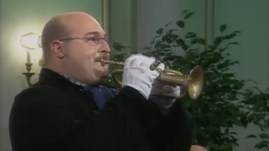Teachers' Domain - Digital Media for the Classroom and Professional Development
User: Preview



Saxton’s Cornet Band, a musical ensemble that recreates the sound and appearance of early brass bands, performs “Yankee Doodle Variations.” Before the performance, Nick Lawrence of the group tells the audience that the piece is an example of theme and variations. After the band’s introduction, the E-flat cornet performs the theme, then the band performs tutti (all together). This is followed by a solo variation, and so on, creating a “one man against the entire band” effect.
Find additional arts resources for your classroom at the KET Arts Toolkit website.
During the 17th and 18th centuries, when settlers from various countries came to the New World, Old World (ancient Greek, Asian, and European) music traditions—such as theories about the science of sounds and the creation of many different timbres (tone colors) of instruments—had been passed down from previous generations. Numerous styles of music from the Renaissance and Baroque periods illustrate how European composers such as Bach and Handel used musical elements of rhythm, melody, harmony, form, timbre, tempo, and dynamics in their compositions. These compositions were performed by colonists in Colonial Williamsburg, Va.
In fact, many styles and genres (categories) of music as well as different types of instruments (English recorder, harpsichord, wooden flutes, violins, etc.) were important to the colonists and used for many purposes. Folk songs and game songs were sung and danced for entertainment. Some folk songs, such as ballads and African spirituals, were sung to express feelings. Music used for ceremonial purposes included, but were not limited to, music for worship and patriotic music for military events.
There are numerous theories about the origins of “Yankee Doodle Dandy.” Some trace back to England, while others find precursors in Ireland, Holland, or other European countries. The song’s history in America is much clearer. The version on the Library of Congress American Memory web site says that the term “Yankee” was used in the mid-1700s to refer to English colonists, and a “doodle” was a silly person or country bumpkin. A British military surgeon, Dr. Richard Schackburg, is credited with writing its first American verses in 1755. The song was meant to make fun of the colonists; however, the colonists took up the tune and made it their own, reportedly singing it during the Revolutionary War battles of Lexington and Concord and proudly calling themselves “Yankees.”
 Loading Standards
Loading Standards